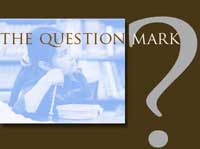The first idea hit me when Birkerts pointed out that we may still be reading even when our book is closed and put aside. I had never thought of that being true until I read his words, but I realized that when I have been reading a story, I will think about the characters and what they might do next as I go about my work day. The same may be true of books I am reading about education or history and politics. Reading is not just what happens when you hold a book in your hand or stare at a laptop or smart phone screen.


Photo © J. McKenzie |
The second important idea - or revelation - was the distinction he made between what he called horizontal and vertical reading. He made the point that very few people owned books before Gutenberg's printing press made them readily and broadly available to the masses. Because there were very few hand-produced books, very few people could read at all, and those who could usually had a very small library -- sometimes a single book like the Bible -- which meant they tended to read certain passages over and over again, pondering their meaning at the deepest level. This he called vertical reading. When books became broadly available, people had access to a much broader selection of books and could, for example, learn about many different countries or peoples. They could skim along the surface and browse through the information instead of pondering deeply. This is what he called horizontal reading. |
At this same time I was doing much writing and thinking about wondering, pondering and questioning as is illustrated by the image below.

Once you accept the idea that reading occurs away from the book, it is not hard to see that writing also occurs away from the page. Few teachers and fewer students are aware of this reality and may, therefore, not be able to exploit the opportunity it represents. Likewise, various forms of imaginative and inventive thought thrive in these regions where incubation may take place.

Photo © J. McKenzie
I was spending many hours each week training for marathons and worried a bit that this extensive training would undermine my writing efforts, but I came to understand that much of my writing actually took place away from the computer while running as I was generating, synthesizing and composing ideas on those two and three hour runs. Later in the day, many of those thoughts might find their way onto a computer screen as I started to compose sentences and paragraphs that were born during my run.
If we teach students about this kind of thinking, their production and power will be greatly enhanced. This possibility is fully described in my article, "Quietude and its relationship to pondering, wondering, questioning and wandering."
Deep time is closely related to deep thinking.
Take Otis Redding’s song, Sitting on the Dock of the Bay
-
- I’m sittin’ on the dock of the bay
- Watching the tide roll away
Ooo, I’m just sittin’ on the dock of the bay
Wastin’ time
This is hardly wasting time. It is this kind of sitting that allows the mind to wander, to wonder and to speculate.
The Stages of Creative Production
Students need to be aware of the powerful role of incubation in the development of ideas, and they should learn the stages of creative production so their writing, reading and thinking will work in concert.

Photo © J. McKenzie
Graham Wallas, in his work Art of Thought, published in 1926, presented one of the first models of the creative process. In the Wallas model, creative insights and illuminations may be explained by a process consisting of 5 stages:
- Preparation (preparatory work on a problem that focuses the individual's mind on the problem and explores the problem's dimensions)
- Incubation (where the problem is internalized into the unconscious mind and nothing appears externally to be happening)
- Intimation (the creative person gets a "feeling" that a solution is on its way)
- Illumination or insight (where the creative idea bursts forth from its preconscious processing into conscious awareness)
- Verification (where the idea is consciously verified, elaborated, and then applied).
|
Since Wallas published his model, there have been many versions, alterations and modifications, but incubation remains an important stage in virtually all of these models.
Some have inserted Frustration as a stage that usually confronts most thinkers. Since this stage almost always accompanies the incubation process, students must be forewarned and prepared for the struggle.
If the student is unaware of the incubation stage and is permitted little time to mull over the challenge at hand, there is every danger that the resulting work will be superficial, hastily constructed and lacking perception and insight. Deep thinking requires a different kind of time. Even if aware of the incubation stage, is the student equipped to bring it on and nurture the fragile flame of creative thought easily snuffed out by the frustration mentioned above as well as various cultural pressures to respect conventional thought and draw (think) within the lines?
Electronic Reading, Writing and Thinking
In recent years I began to explore how electronic or digital reading might influence comprehension through the enhanced note-taking, commenting, and research capabilities offered by some of the ebook software programs.
I was influenced by Alan Reid, who published an article "Knowtation: Reading and Thinking Between the Lines and Around the Edges" in my educational technology journal, From Now On.
| Alan coined the term Knowtation -- "the skillful use of annotation strategies with print or electronic reading devices in order to enhance comprehension." |

Photo © J. McKenzie |
Alan had found research indicating that these annotation stratgies might strengthen students' understanding of texts, so this led me to write two articles pushing the inquiry further.
In January of 2012, I published "eReading: How is reading changing with the advent of eBooks?"
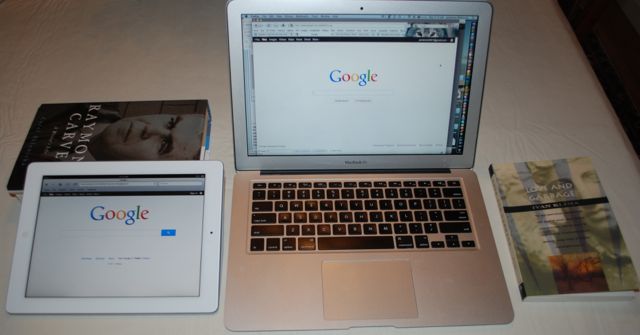
Photo © J. McKenzie
That article is worth reading in its entirety, but just for the sake of illustrating how knowtation can produce a partnership between writing, reading and thinking, I will reproduce one section here that provides examples.
Tasks for readers . . .
1) Insert at least one question as a note on each two pages you read. During your reading, make sure you alternate across the types listed below:
a. A question about character
b. A question about theme
c. A question about plot
d. A question about a literary device
e. A question requiring forecasting/predicting
f. A question about a central idea or concept
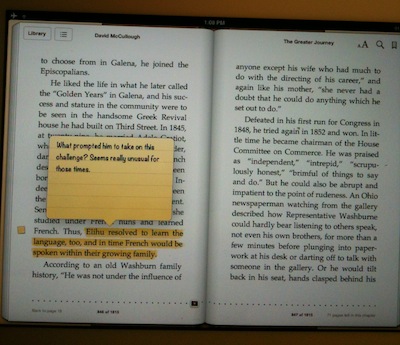
2) Insert 2-3 interpretive notes in the most important paragraphs on each pair of pages
3) Highlight every word you look up
4) Each time you search the Web for something to enrich your understanding, insert a note and type in what you found
5) Highlight the most important 2-3 sentences on each pair of pages
6) Highlight in different color anything you find confusing
7) Since this ebook has few pictures, find a picture of each place that is mentioned and paste a copy of the picture or its URL in a note
8) Do the same as above in #7 for the paintings or photos mentioned |
Many years earlier I enjoyed an approach to managing classroom dialogue that was called "Writing for Thinking." I can find no source currently for that model, but the phrase "Writing for Thinking" produces a rich batch of Web sites promoting various approaches to accomplishing what this article is advocating.

Photo © iStock.com
Back in the 1970s and the 1980s, this strategy involved all students in taking a few minutes to write down their thoughts to a challenging question before the class might engage in discussion. In many classrooms, discussions are otherwise dominated by a small handful of students with teacher "wait time" usually quite limited, so this strategy broadens involvement and gives the teacher a chance to roam throughout the classroom and assess which students seem to understand the question and which do not.
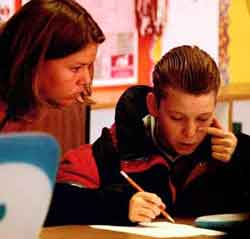
Photo © J. McKenzie
In today's classroom, a teacher might still ask students to write their thoughts down on paper, perhaps creating cluster diagrams, or in those classrooms with plenty of laptops, the teacher may ask them to do the following:
"What kind of man was Jay Gatsby?"
"Open your laptops and start up the mind mapping software. In the center of the diagram, type 'Gatsby's character traits' and then click on 'Rapid Fire' and see if you can come up with ten good words that describe him."
The teacher can then walk around the room and see their thinking emerge.
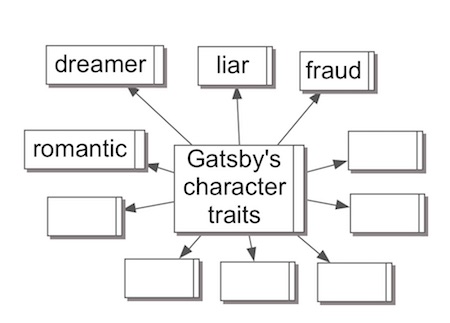
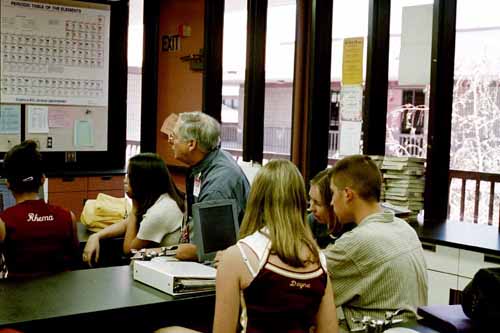
Photo © J. McKenzie
Instead of tossing the question out to the class without this thinking and writing stage, which would permit the "automatic hands" to dominate the discussion and the slackers to disengage, the teacher is making sure that no one is just speaking "off the top of their heads" and everyone is giving the question serious consideration. This technique brings everyone's thinking out into the open.
After a good first effort, the teacher can then ask class members to share words they have listed on their mindmaps and encourage copying others' words before sending everyone to one or more of the online thesaurus Web sites mentioned in this month's companion piece, "The marriage of vocabulary and creative thought" to further enrich and expand their lists.
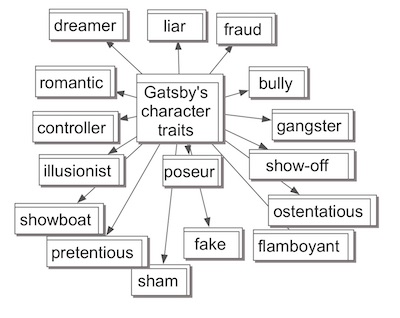
Subsequently, the teacher will ask students to gather evidence of character from the novel, attaching incidents to their matching words.
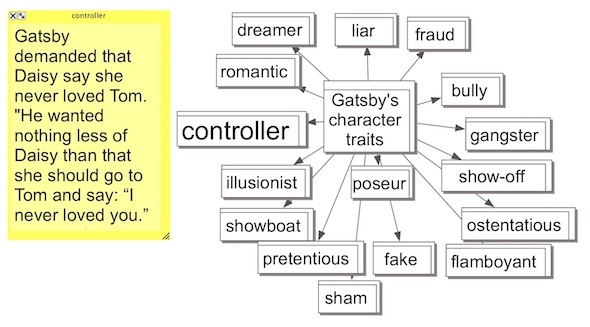
Hopefully, this kind of thinking, reading and writing can become a sustained, natural habit of the students that will enrich their capacity to comprehend and invent.
|

